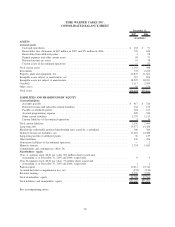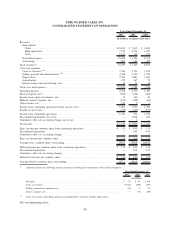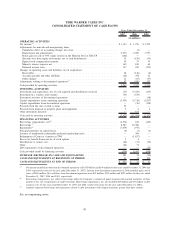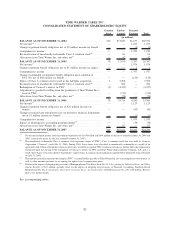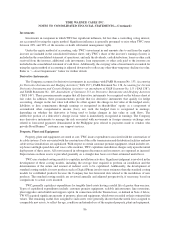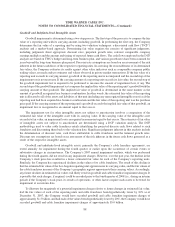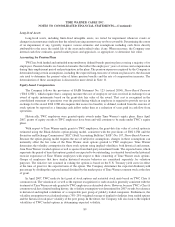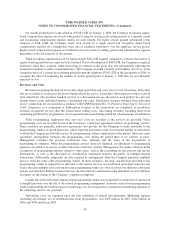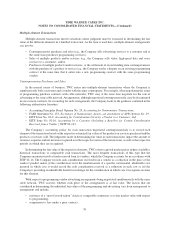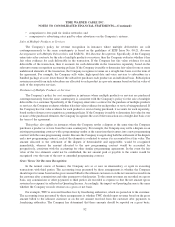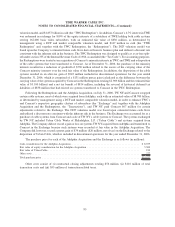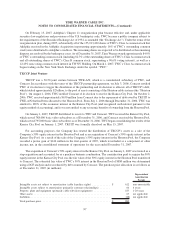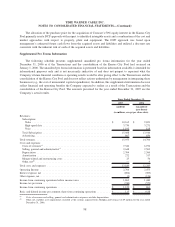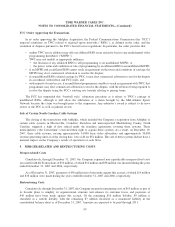Time Warner Cable 2007 Annual Report Download - page 94
Download and view the complete annual report
Please find page 94 of the 2007 Time Warner Cable annual report below. You can navigate through the pages in the report by either clicking on the pages listed below, or by using the keyword search tool below to find specific information within the annual report.Long-lived Assets
Long-lived assets, including finite-lived intangible assets, are tested for impairment whenever events or
changes in circumstances indicate that the related carrying amounts may not be recoverable. Determining the extent
of an impairment, if any, typically requires various estimates and assumptions including cash flows directly
attributable to the asset, the useful life of the asset and residual value, if any. When necessary, the Company uses
internal cash flow estimates, quoted market prices and appraisals, as appropriate, to determine fair value.
Accounting for Pension Plans
TWC has both funded and unfunded noncontributory defined benefit pension plans covering a majority of its
employees. Pension benefits are based on formulas that reflect the employees’ years of service and compensation
during their employment period and participation in the plans. The pension expense recognized by the Company is
determined using certain assumptions, including the expected long-term rate of return on plan assets, the discount
rate used to determine the present value of future pension benefits and the rate of compensation increases. The
determination of these assumptions is discussed in more detail in Note 11.
Equity-based Compensation
The Company follows the provisions of FASB Statement No. 123 (revised 2004), Share-Based Payment
(“FAS 123R”), which require that a company measure the cost of employee services received in exchange for an
award of equity instruments based on the grant-date fair value of the award. That cost is recognized in the
consolidated statement of operations over the period during which an employee is required to provide service in
exchange for the award. FAS 123R also requires that excess tax benefits, as defined, realized from the exercise of
stock options be reported as a financing cash inflow rather than as a reduction of taxes paid in cash flow from
operations.
Historically, TWC employees were granted equity awards under Time Warner’s equity plans. Since April
2007, grants of equity awards to TWC employees have been and will continue to be made under TWC’s equity
plans.
With respect to Time Warner equity grants to TWC employees, the grant-date fair value of a stock option is
estimated using the Black-Scholes option-pricing model, consistent with the provisions of FAS 123R and the
Securities and Exchange Commission (“SEC”) Staff Accounting Bulletin (“SAB”) No. 107, Share-Based Payment.
Because the option-pricing model requires the use of subjective assumptions, changes in these assumptions can
materially affect the fair value of the Time Warner stock options granted to TWC employees. Time Warner
determines the volatility assumption for these stock options using implied volatilities, both historical and current,
from Time Warner’s traded options as well as quotes from third-party investment banks. The expected term, which
represents the period of time that options granted are expected to be outstanding, is estimated based on the historical
exercise experience of Time Warner employees with respect to their ownership of Time Warner stock options.
Groups of employees that have similar historical exercise behavior are considered separately for valuation
purposes. The risk-free rate assumed in valuing the options is based on the U.S. Treasury yield curve in effect
at the time of grant for the expected term of the option. The Company determines the expected dividend yield
percentage by dividing the expected annual dividend by the market price of Time Warner common stock at the date
of grant.
In April 2007, TWC made its first grant of stock options and restricted stock units based on TWC Class A
common stock. The valuation of, as well as the expense recognition for, such awards is generally consistent with the
treatment of Time Warner awards granted to TWC employees as described above. However, because TWC’s Class A
common stock has a limited trading history, the volatility assumption was determined for 2007 awards by reference
to historical and implied volatilities of a comparable peer group of publicly traded companies. Furthermore, the
volatility assumption was calculated using a 75%-25% weighted average of implied volatilities from traded options
and the historical stock price volatility of the peer group. In the future, the Company will also look to the implied
volatilities of TWC traded options in determining expected volatility.
89
TIME WARNER CABLE INC.
NOTES TO CONSOLIDATED FINANCIAL STATEMENTS—(Continued)


